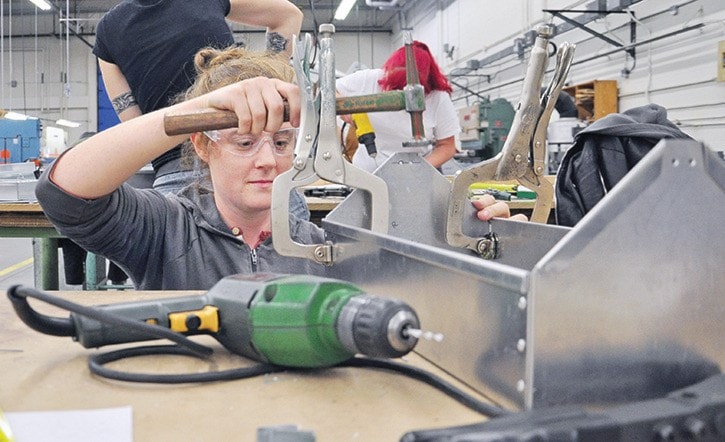In Camosun College’s sheet metal workshop, students hammer and contort metal for HVAC systems and toolboxes. Whether they stick with this trade remains to be seen, but the college and the province are trying to make entry into trades education as easy and enticing as possible.
The Ministry of Advanced Education announced recently that it is granting Camosun $349,000 for 68 seats in carpentry and electrical foundation programs, introductory trades training without the onerous requirement of securing an apprenticeship.
That ministry funding also opens 32 seats in the discovery skills program, a pilot project where students dip their toes in a number of trades at the Interurban campus.
“What is intended here is to provide the opportunity to have a more informed entry into trades,” said Olaf Nielsen, chair of trades development and special projects at Camosun. “This helps make a more informed career decision.”
Ministry of Advanced Education-funded seats adds to the 336 funded by the Industry Training Authority at Camosun for foundation programs. The ITA focuses mainly on apprenticeships, and funded 1,812 of those seats at the college this year.
Nielsen said foundation programs help expose more people to less well known but still highly employable trades.
“A lot of individuals don’t have a good picture of the pathways into trades. A lot gravitate towards traditional trades,” he said. “We see some undersubscribed programs where there’s not a lot of awareness, like pipe trades, for example. A lot of students don’t know about being a steamfitter or gas fitter.”
Eric Sehn, Camosun’s dean of trades and technology, said apprenticeship numbers tend to rise and fall with the economy and infrastructure spending.
If companies aren’t hiring and sponsoring apprenticeships, fewer people enter trades training. Trade foundation programs help fill the gap, Sehn said, and gives graduates school credit toward an apprenticeship.
“It’s important during times when the economy is quite soft and vulnerable. Students can join the foundation program without a sponsor,” he said, noting that while shipbuilding is ramping up, some construction related trades have taken a hit over the past few years.
“It can be really challenging to find an apprenticeship when the economy is down and employers aren’t taking on staff.”
The discovery skills program, which covers everything from electrical to auto repair to metal work to welding, is the “trades sampler,” Sehn said, and can lead to a foundation program or even an apprenticeship.
This is the first time the Ministry of Advanced Education has funded discovery skills and opened it to a wider audience – previously the curriculum was focused on specific programs for women and aboriginal students.
“It all has the same goal, giving people the opportunity to experience trades training to see what it most aligned with their interests and skills,” Sehn said.
“I’m most happy when I see someone in discovery skills move on to a foundation program. If I see them year after year, I know they are on their way. That’s what we want to see happen.”
editor@saanichnews.com
